Related Research Articles

Cyril Northcote Parkinson was a British naval historian and author of some 60 books, the most famous of which was his best-seller Parkinson's Law (1957), in which Parkinson advanced Parkinson's law, stating that "work expands so as to fill the time available for its completion", an insight which led him to be regarded as an important scholar in public administration and management.

The Straits Settlements were a group of British territories located in maritime Southeast Asia, then known as the Far East. Headquartered in Singapore for more than a century, it was originally established in 1826 as part of the territories controlled by the British East India Company, the Straits Settlements came under British Raj control in 1858 before being split under direct British control as a crown colony on 1 April 1867. In 1946, following the end of the Second World War and the occupation by Japan, the colony was dissolved as part of Britain's reorganisation of its dependencies in the area.
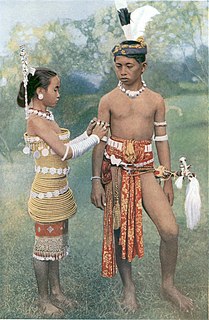
The Dayak or Dyak or Dayuh are one of the native groups of Borneo. It is a loose term for over 200 riverine and hill-dwelling ethnic groups, located principally in the central and southern interior of Borneo, each with its own dialect, customs, laws, territory, and culture, although common distinguishing traits are readily identifiable. Dayak languages are categorised as part of the Austronesian languages. The Dayak were animist in belief; however, since the 19th century there has been mass conversion to Christianity as well as Islam due to the spreading of foreign religions.
Chinatown is a subzone and ethnic enclave located within the Outram district in the Central Area of Singapore. Featuring distinctly Chinese cultural elements, Chinatown has had a historically concentrated ethnic Chinese population.
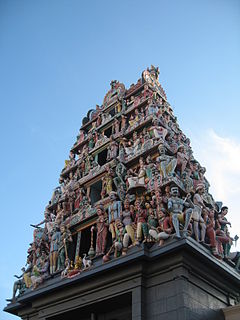
The Sri Mariamman Temple is Singapore's oldest Hindu temple. It is an agamic temple, built in the Dravidian style. Located at 244 South Bridge Road, in the downtown Chinatown district, the temple serves the majority Hindu Singaporeans, Tamilians, in the city-state. Due to its architectural and historical significance, the temple has been gazetted a National Monument and is a major tourist attraction. Sri Mariamman Temple is managed by the Hindu Endowments Board, a statutory board under the Ministry of Community Development, Youth and Sports.

Malacca City is the capital city of the Malaysian state of Malacca. As of 2019 it has a population of 579,000. It is the oldest Malaysian city on the Straits of Malacca, having become a successful entrepôt in the era of the Malacca Sultanate. The present-day city was founded by Parameswara, a Sumatran prince who escaped to the Malay Peninsula when Srivijaya fell to the Majapahit. Following the establishment of the Malacca Sultanate, the city drew the attention of traders from the Middle East, South Asia, and East Asia, as well as the Portuguese, who intended to dominate the trade route in Asia. After Malacca was conquered by Portugal, the city became an area of conflict when the sultanates of Aceh and Johor attempted to take control from the Portuguese.

Raffles Place is the centre of the Financial District of Singapore and is located south of the mouth of the Singapore River. It was first planned and developed in the 1820s as Commercial Square to serve as the hub of the commercial zone of Singapore in Raffles Town Plan. It was renamed Raffles Place in 1858 and is now the site of a number of major banks. It is located in the Downtown Core within the Central Area, and features some of the tallest buildings and landmarks of the country.
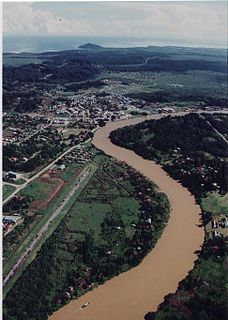
Lawas is a small town and the capital of Lawas District, Limbang Division, Sarawak, Malaysia. This district area is 3,811.9 square kilometres, and population was 35,300. It is 1200 km from the state capital, Kuching and 200 km from the capital city of Sabah, Kota Kinabalu.

The Central Area, also called the City Area, and informally The City, is the city centre of Singapore. Located in the south-eastern part of the Central Region, the Central Area consists of eleven constituent planning areas: the Downtown Core, Marina East, Marina South, the Museum Planning Area, Newton, Orchard, Outram, River Valley, Rochor, the Singapore River and Straits View, as defined by the Urban Redevelopment Authority. The term Central Business District (CBD) has also been used to describe most of the Central Area as well, although its boundaries lie within the Downtown Core.

Telok Ayer MRT station is an underground Mass Rapid Transit (MRT) station on the Downtown line (DTL). Situated in Outram, Singapore, the station serves various offices and commercial developments around the junction of Cross Street and Telok Ayer Street. The station is operated by SBS Transit.

The Johor–Singapore Causeway is a 1.056-kilometre (0.66 mi) causeway consisting of a combined railway and motorway bridge that links the city of Johor Bahru in Malaysia across the Straits of Johor to the district and town of Woodlands in Singapore. Historically, it was the only land connection between the two countries until the opening of the Tuas Second Link in 1998.

Hong Lim Park, formerly known as Hong Lim Green and Dunman's Green, is a 0.94-hectare (2.3-acre) heritage park in the Downtown Core district of Singapore located next to the Parkroyal Collection Pickering hotel and Clarke Quay station.

The Nazi party rally grounds covered about 11 square kilometres in the southeast of Nuremberg, Germany. Six Nazi party rallies were held there between 1933 and 1938.
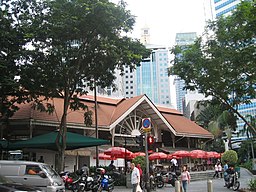
Lau Pa Sat, also known as Telok Ayer Market, is a historic building located within the Downtown Core in the Central Area of Singapore. It was first built in 1824 as a fish market on the waterfront serving the people of early colonial Singapore and rebuilt in 1838. It was then relocated and rebuilt at the present location in 1894. It is currently a food court with stalls selling a variety of local cuisine.
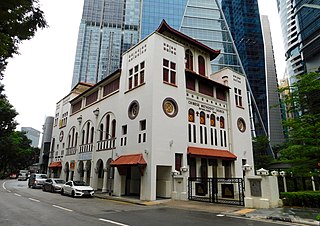
Telok Ayer Chinese Methodist Church, is located on Telok Ayer Street within the Downtown Core of Singapore's central business district. The church is approximately 450 metres from Telok Ayer MRT station.

Telok Ayer Street is a street located in Singapore's Chinatown within the Outram district, linking Church Street to Cecil Street. Telok Ayer MRT station is located at the junction of Cross Street and this road.
Kapitan China Tan Kim Ching, also known as Tan Kim Cheng, was a Singaporean politician and businessman. He was the eldest of the three sons of Tan Tock Seng, the founder and financier of Tan Tock Seng Hospital. He was consul for Japan, Thailand and Russia, and was a member of the Royal Court of Siam. He was one of Singapore's leading Chinese merchants and was one of its richest men in Singapore at that time. He was also the first Asian member of the Straits Branch of the Royal Asiatic Society. After his father, Tan Tock Seng's death, he became the Kapitan China of the Straits Chinese community. He is believed to have been the head of the Triad in Malaya.
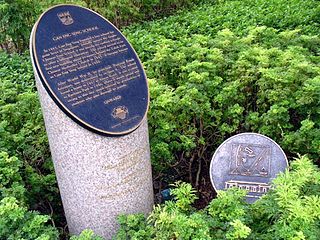
The Gan Eng Seng School's Founding Site, marked by twin commemorative plaques at present, is located at the junction of Telok Ayer Street and Cecil Street in the southern part of Singapore, near the Telok Ayer Chinese Methodist Church. On 30 August 1997, the site was designated as a national historical site along with five other schools by the National Heritage Board (NHB), being one of the oldest educational establishments in Singapore. The others are Raffles Institution, Raffles Girls' School, St Margaret's Secondary School, Singapore Chinese Girls' School and Anglo-Chinese School.

Sophia Blackmore was an Australian missionary. She founded the Fairfield Methodist Schools, and also Methodist Girls' School in Singapore. She was the first woman missionary sent by the Woman's Foreign Missionary Society of the Methodist Episcopal Church to Singapore. She also set up a boarding home for girls, supported the early Methodist Straits Chinese Christian work, published a Christian periodical in Baba Malay and is closely associated with the founding of Kampong Kapor Methodist Church.

Katong Park is neighborhood park located in Katong, Singapore at the junction of Meyer Road and Fort Road. Built in the 1930s above the buried remains of Fort Tanjong Katong, it was one of Singapore’s oldest parks with the first public bathing pagar and was highly popular with families during the weekends. After the coastal reclamation works in the 1970s, the park lost its sea frontage and declined greatly in popularity. It now remains as a small community park serving nearby residents.
References
- Straits Budget, 6 January 1922
- Official Guide: Malaya Borneo Exhibition, Singapore 1922